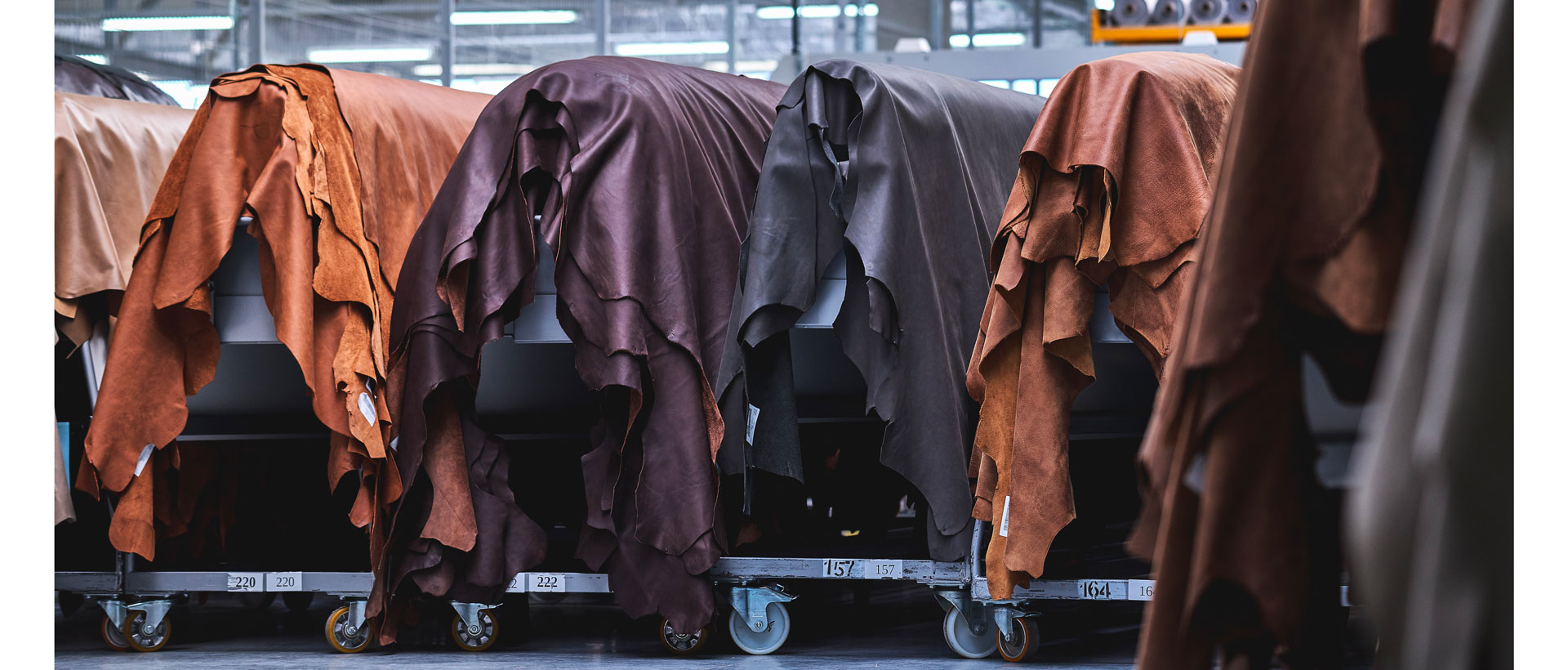La Pelle
 |
- Maxcom Leather
- Leather quality control
- Testing
Leather is a natural product which goes trough an industrial process (tanning) in order to be used in various application which in Maxcom case are furniture upholstery and automotive, jet and yacht interiors.
This is a short introduction to this unique material.
 |
Production process
3 are the most important processes in the making of :
-A first tanning process, usually chrome-based (wet blue) or vegetal-oil based, which gets the leather ready to absorb other tanning agents and the background color.
- Then the leather faces another run in the tanning barrels, with more aniline (for the background color) and the tanning agents which enrich elasticity, tenderness and structure. Once properly dried we have the so called Crust. Since the life of the animal impacts on the surface quality with natural defects, punctures and scars, in between this phase and the following is it possible to minimize those imperfection trough embossing, buffing and stucco.
- The leather is then "finished" meaning it is given the final aspect trough color effects, gloss or mat, texture and greasiness.
Once the production is done the hides are measured with a laser measuring machine, which prints the surface area value on the back of the hide (Maxcom uses square meters) with a warm ink stamp. Surface obviously vary from hide to hide, but through an accurate selection process we have hides with a limited surface range.
Our site gives you the opportunity to select the hides whose combination better match your need!
.
Maxcom leather
All the products shown in this website are Maxcom Leather exclusive, developed and styled by our designers and realized by the best tanneries in Italy. Each one of them is the final step in the continuous pursuit of a product that is both beautifully handcrafted and also standardized to meet industrial requirements.
In the SHOP you can browse 3 main categories:
Each one of them includes products that differ for production method, technical properties, selection standards and testing requirements. Below a short guide that will drive you in the shopping process.
 |
Leather quality control
Several are the elements to consider that may impact on the final exterior look of an hide and several are also the techniques that may be applied to reduce this impact.
First we have to consider the geographical area where the animal was born and raised and the sex of the animal. The area will determine whether or not certain natural defects will be present (i.e. tick or hump in South American hides) and will provide significative information about its physical attributes such elasticity, tenderness, etc.
 |
Then we have to consider what kind of color agent we are using. From the more transparent:
- Aniline (Sensual, Return)
- Semianiline (Mirror, Ercules, Splendor)
- Pigmented (Tibet, Ru, Automotive)
A third matter is related to the first two. Depending on the presence of natural defects (i.e. insect bites, cuts, healed wounds, tick, “cisti “, etc.) we can perform some techniques such as “smeriglio”(buffering), “stuccatura”(stucco), “palissonatura” to lower the visual impact of these defects.
A fourth element is the “finishing” techniques used to obtain the overall look and touch. Those results in having an aged look (Athena), a pull-up effect (Return) or a “movement” effect like the one given by hand painted tips (Splendor).
At the end of the production process the control process begins, by testing all the production lots according to the technical sheet requirements and selecting each hide:
Automotive
Every hide MUST have at least 3 clean (no defects) 60x70 cm surfaces. Max 1 “closed” defect (healed cuts of 10 cm maximum length) is allowed in a non-central area of the surface. The hide MUST NOT have extended areas of “soffiature” (surface layer partial detachment) and wrinkles.
Defects will be considered: open scars, wounds, ticks, calluses and marks. The hide might have hump (which is not calculated by the measuring machine)
Furniture Aniline and Semianiline
Every hide MUST have at least 3 clean (no defects) 60x70 cm surfaces. Max 1 “closed” defect (healed cuts of 10 cm maximum length) is allowed in a non-central area of the surface. Small veins (not extended and not visible on the back), small texture differences, small scars (not groups of) are to be considered as signs of the natural (and not embossed or buffed) leather. The hide MUST NOT have extended areas of “soffiature” (surface layer partial detachment) and wrinkles. Defects not to be included in the clean area will be considered: open scars, wounds, ticks, calluses and marks.
 |
Pigmented
Every hide MUST have at least 3 clean (no defects) 60x70 cm surfaces. Max 1 “closed” defect (healed cuts of 10 cm maximum length) is allowed in a non-central area of the surface. The hide MUST NOT have extended areas of “soffiature” (surface layer partial detachment) and wrinkles. Defects not to be included in the clean area will be considered: open scars, wounds, ticks, calluses and marks.
 |
Testing
Every product has been tested according to the most recent European and American standards. You might find the tests list in the product technical sheet, in the shop product page. Every production lot is tested by our specialists and periodically we counter test the result in certified institutes in Italy and USA.


